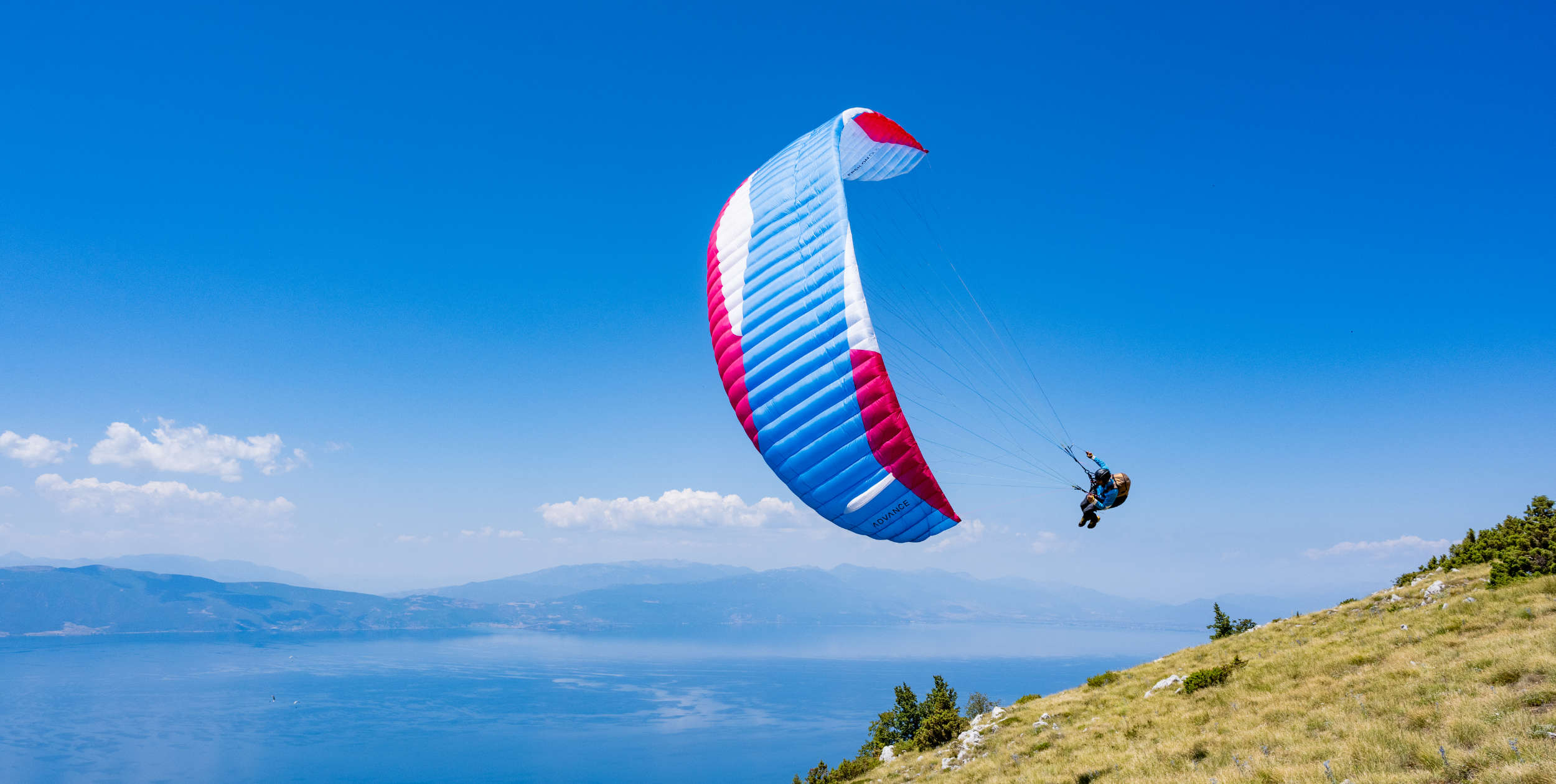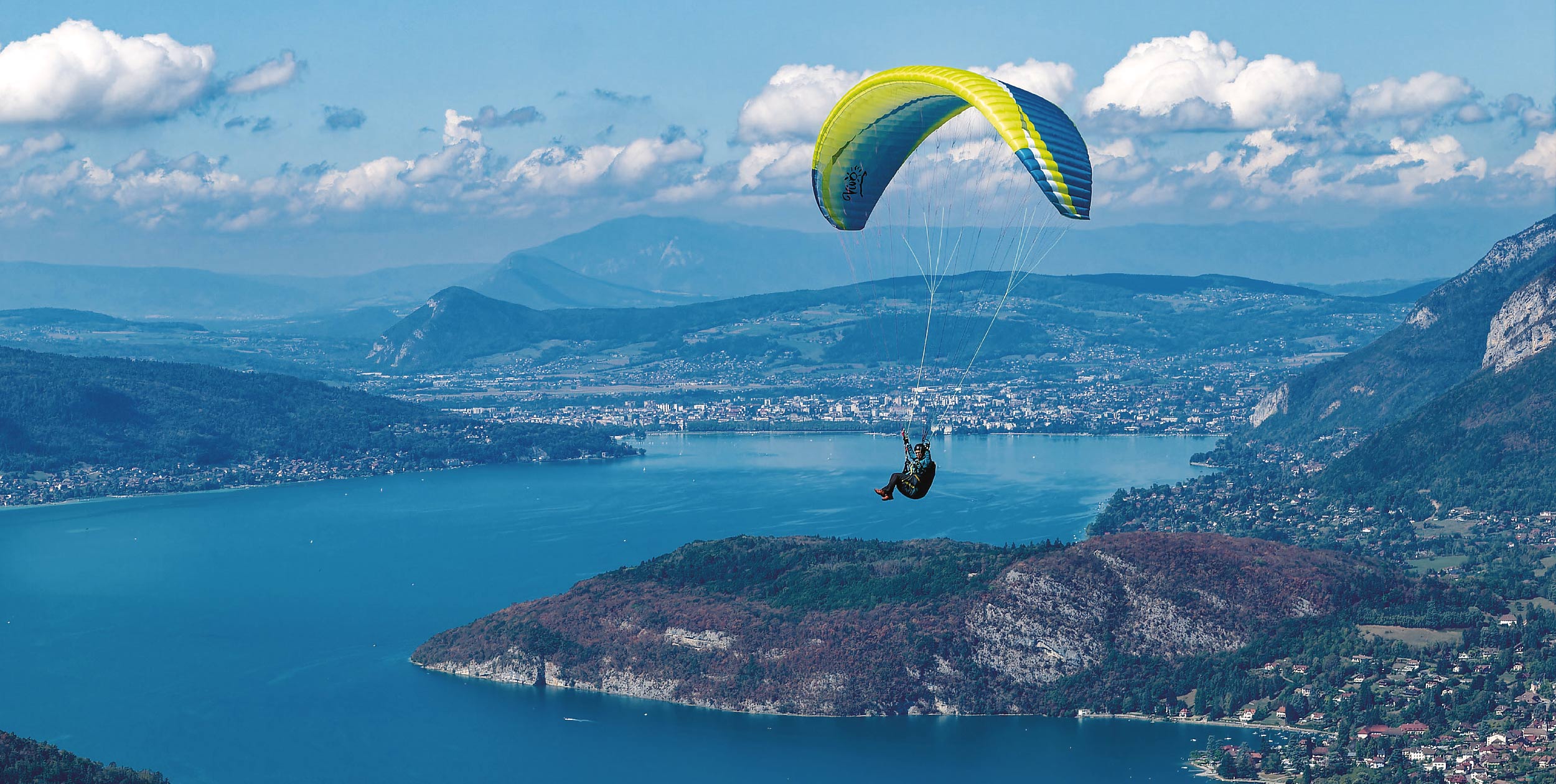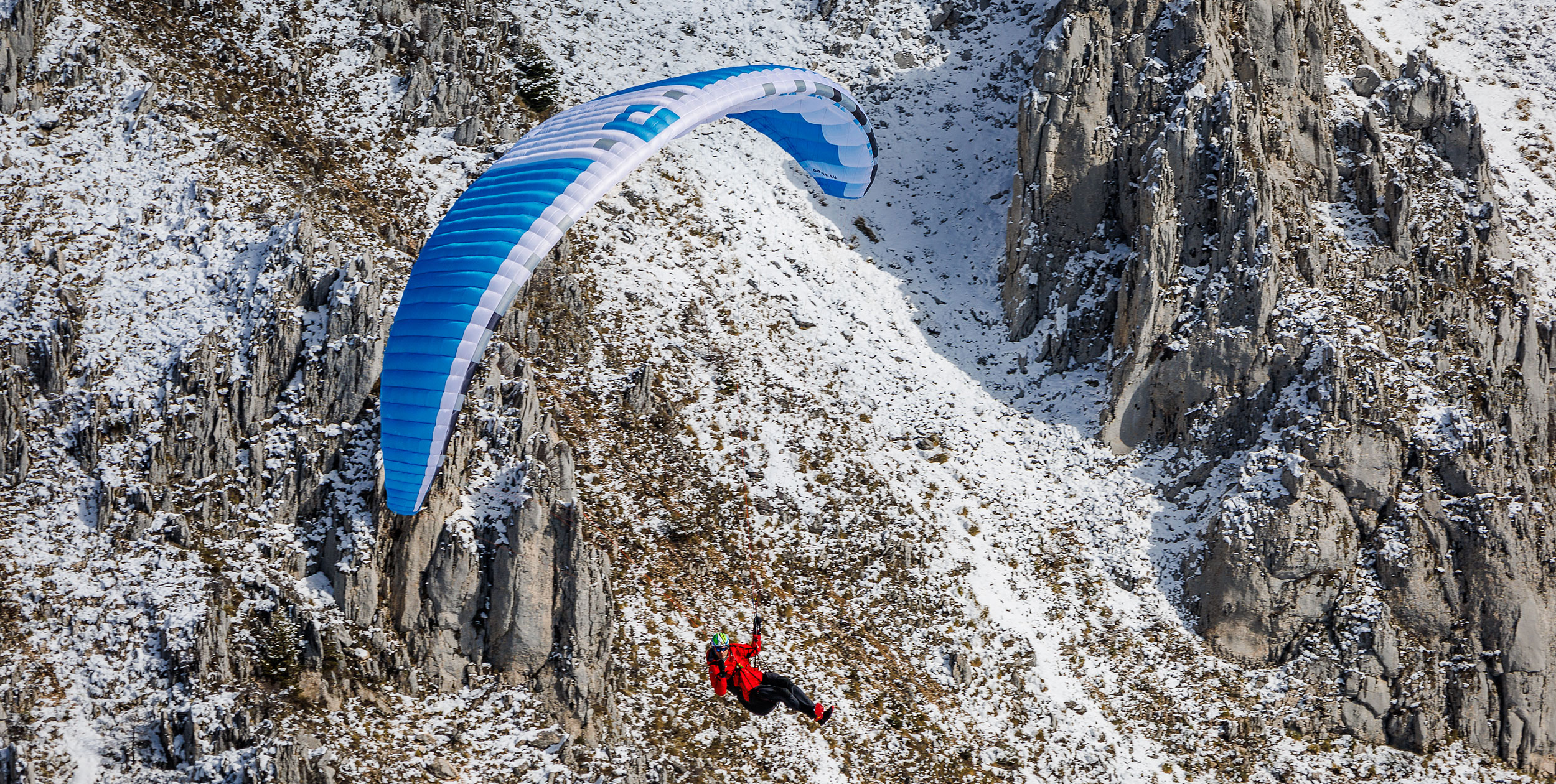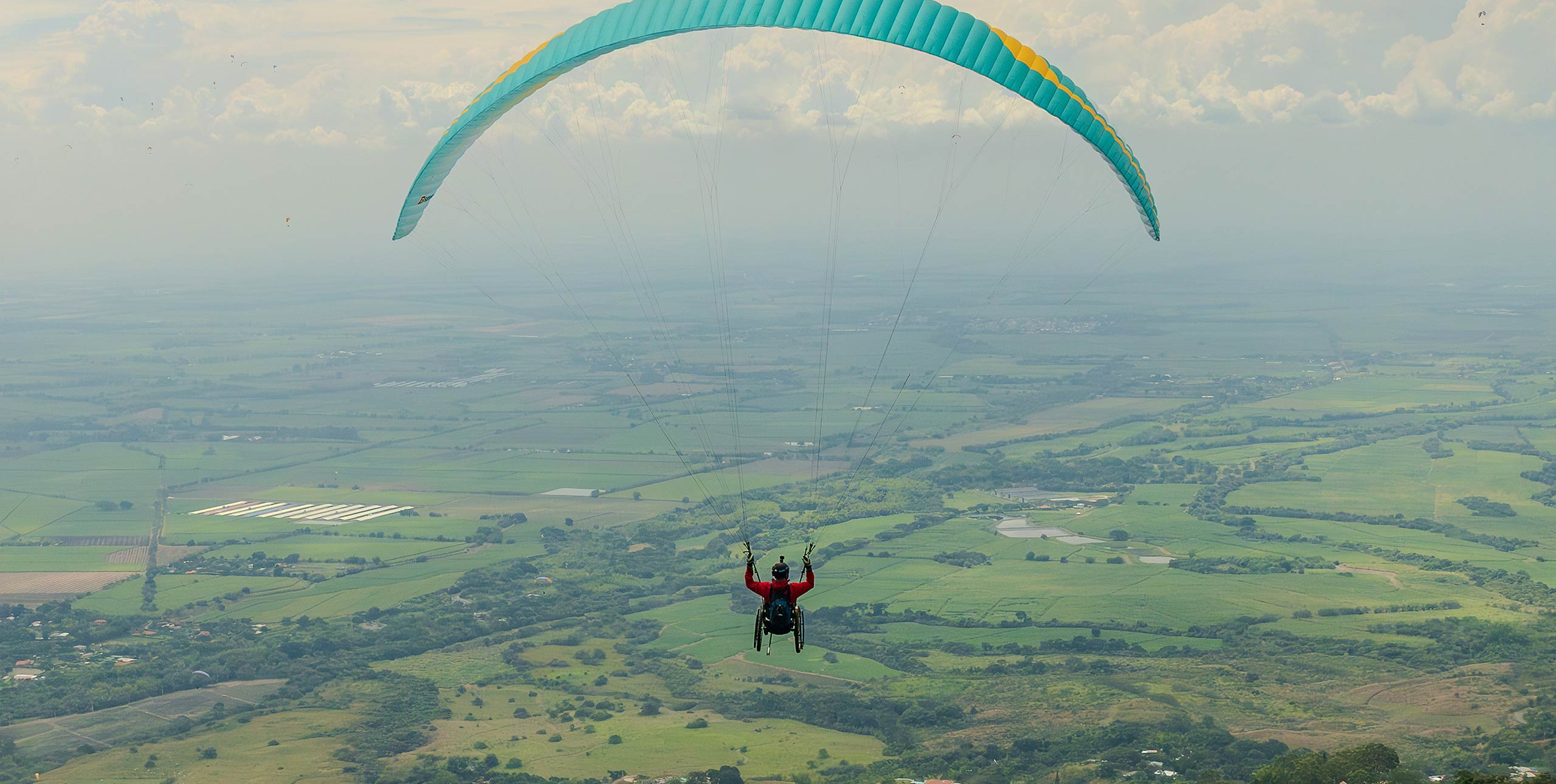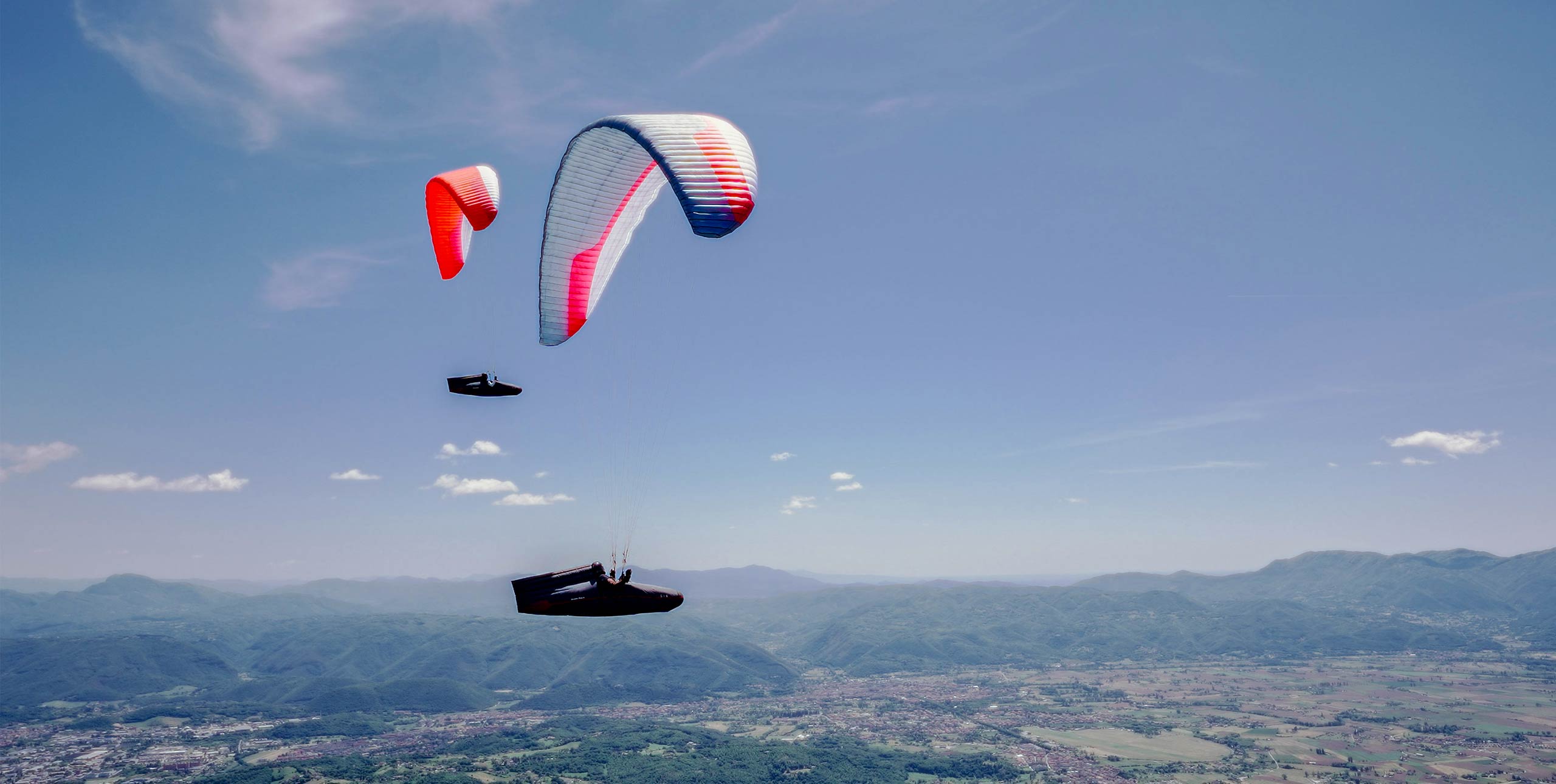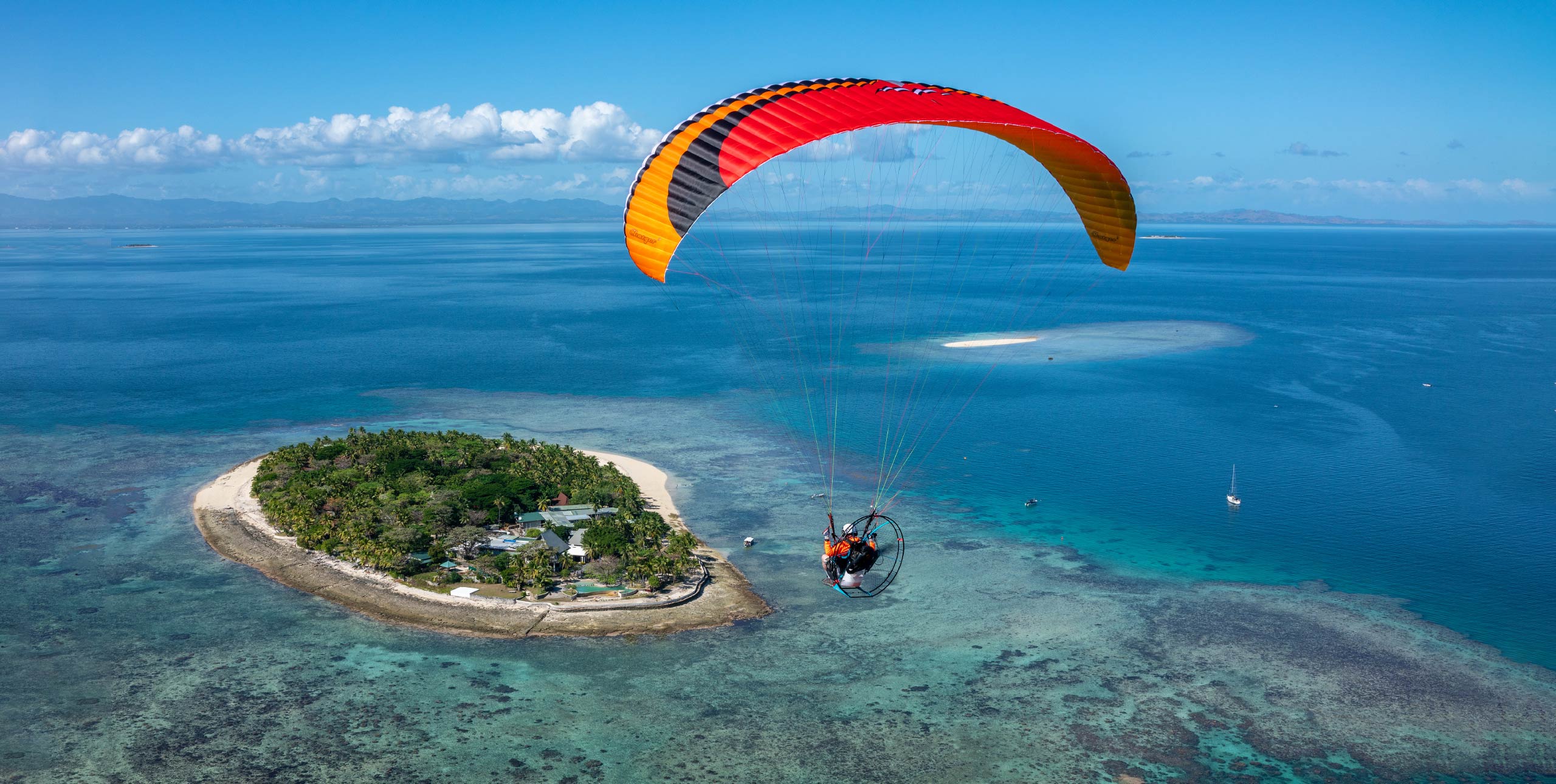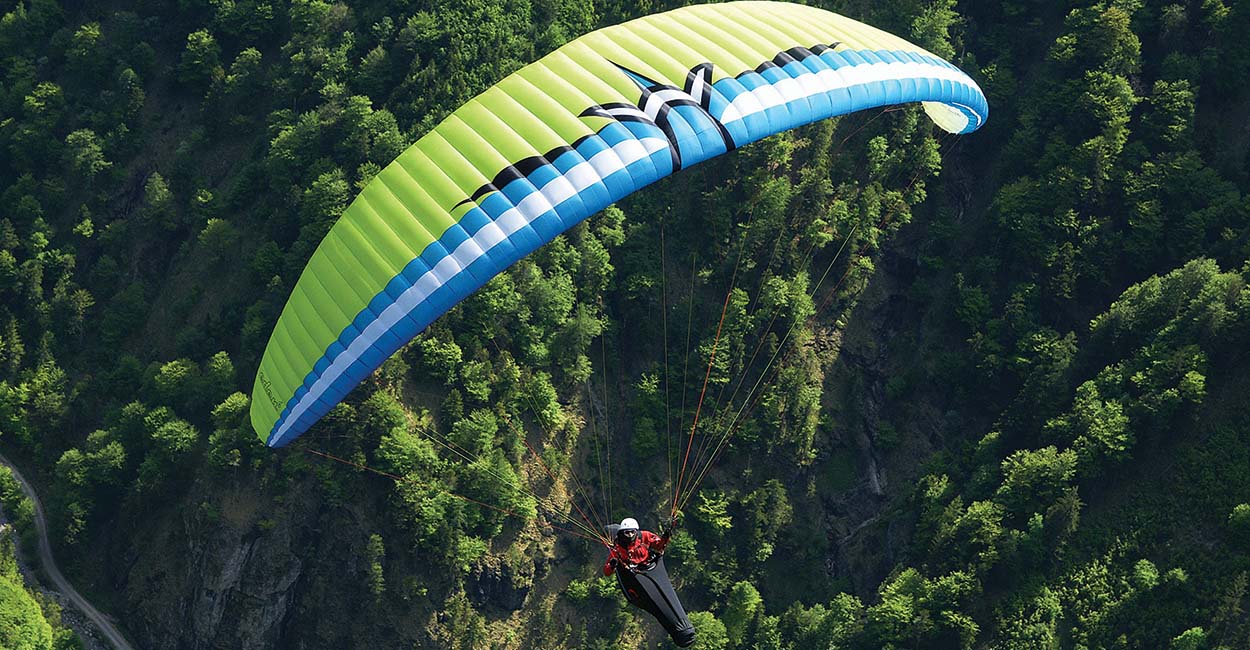
I REVIEWED the Eden’s EN-C big brother, the Elan, in issue 159 and then flew it for a year in the British comps. The glider gave a comfortable ride but with plenty of performance, allowing me to enjoy the ride home on the goal bus on several occasions.
This year saw the introduction of the latest incarnation of the long-running Eden series. The similarity in looks between this and the Elan are obvious, so would it have performance to match? And would this come at the cost of EN-B ease of use?
First outings
I first got my sweaty hands on the Eden 6 during the Kössen testival in early summer. Glider in hand I headed up the cablecar to launch. There I found the wind rather fickle, and as I set up I watched a few rather interesting take-off performances (search ‘Kossen Takeoffs’ on YouTube and you will find a compilation).
I managed to keep myself out of the video thanks to the easy launching characteristics of the Eden. Doing a forward launch it rose easily overhead with very little control needed to stop it overshooting. A few steps and I was off, heading towards the masses thermalling in front. This easy launch behaviour was repeated every time I flew with the Eden 6.
Taking off from Kössen often involves making a quick decision on which side to find your first thermal; the wind is often on the northerly slope but the sun is on the southerly. Do you go for easy-but-gentle or strong-but-leeside? Spotting a glider climbing quickly in the sun, I threw myself into the lee side.
As I hit the sharp edge of the leeside thermal the wing bit in nicely rather than being kicked back as some older wings do – a sign of the modern nose design Mac Para have used. Once inside, a good dose of weightshift and brakes and I had the wing cranked up. This was not time to explore the handling – what was important was turning tightly to stay in the core till I had ridden out of the lee.
Being on the wing was like coming back home and the family likeness was immediately noticeable. In the rough climb the precise handling of the wing made it easy to keep in the best parts of the lift.
As the summit of the mountain fell away and the thermal widened and smoothed out I could let the turns widen. The brakes have an instant effect and are nicely progressive. The first part of the travel will give a good flat and efficient turn that has obviously been carefully trimmed. It has a similar feel to the Rook 2 in this respect, but I found it a little easier to crank over when the need arose. Like the Rook 2 it has less roll than a Mentor 4 or a Base.
Heading off on glide and feeling right at home on the wing straight away I was able to push into the bigger mountains to the southwest, a range I had always wanted to get up close to in previous years. The wing’s immediate feel of security is a boon as you head into big country. It doesn’t stress you out, instead leaving you relaxed and able to get on with the job in hand.
Heading back I made full use of the bar, which has light enough pressure to use all day. The wing seems secure on the bar, cutting through any turbulence rather than being blocked by it and floating in the lift. There is an absence of any C-handles on the Eden; there is little need for them but you can control the wing by direct pulls on the risers.

The design
Although the Eden and Elan look similar in the air, up close you can see obvious differences in the technology used. The flat aspect ratio has seen an increase over the Eden 5 from 5.6 to 5.91, sitting below that of the Elan that sits above the 6.0 mark. This puts it higher than the Ozone Rush 4 and Nova Mentor 4 but less than the UP Summit XC3 and GIN Carrera Plus. The Carrera Plus and Summit XC3 both have an A/R of more than 6.0 and are arguably aimed at higher-level pilots.
A lot of attention has clearly been lavished on the leading edge, and the construction is a lot more complicated than the previous Eden or the Elan. As you would expect these days there is a sharknose.
On the top surface you will find three seams that are used to create the 3D shaping, an increase from the previous model. This is done to avoid creases in this vital part of the aerofoil. The Eden 6 also borrows technology from the old Magus comp wings and the new EN-D Icon in the shape of the GIN-patented Rigifoils in the centre of the top surface of each cell.
Explaining this, designer Petr Recek said: “Clean leading and trailing edges are always the key for aerodynamic performance. The Rigifoil gives the Eden 6 a solid leading edge and although it is costly it offers a better glide in accelerated flight. As soon as you go on bar you can feel the difference.” At the back the wing has mini-ribs.
All this technology hasn’t meant a heavier wing. In fact it’s a few grams lighter than its predecessor. The weight ranges have also seen an increase in the top weights.

The line-set has been further optimised and the Eden 6 is a true three-liner, unlike the Eden 5 that had D attachment points coming off the C-risers. This reduction of line and corresponding drag hasn’t come at the cost of wrinkles in the area of the Cs, which Mac Para have managed to keep very clean.
The upper cascade on the new Eden is unsheathed, but as these lines normally lie on the wing on take-off this shouldn’t cause any problems. Paraglider design is all about compromises Petr said: “Even with a lower aspect ratio and safer aerofoils the use of the rigifoils and thinner main lines gives us a better glide when accelerated, over the Elan.”
The risers are thin race-style and use good quality components including Harken pulleys on the speed system. The different risers and sheathed lower lines are coloured, making it easy to see what is what. Some might like the brake handles to be a bit bigger and better padded but I found they fit well in my hands.
Flying Circuits
Back home in the southern Alps I was able to take the Eden out for some circuits. Flying the size 26 right at the top of its weight range (78kg-100kg) meant I had more authority in the strong climbs. When climbing out from launch though I found myself at no disadvantage in the climbs, emphasising the great climb ability of the wing.
In thermals the Eden 6 gives a good level of information about the position of the core, through the risers, without it being a jittery ride. In fact, everything feels very smooth and calm and you are ushered towards the best lift by a push at your hips. That combined with the precise handling meant I very quickly was able to thermal without particularly concentrating on it, freeing my mind to look at the route possibilities ahead and assessing the general conditions.
The wing is trimmed towards cross country, but that’s not to say you can’t have fun on it. Adding more brake and weightshift brings out its sporty and dynamic side. While the Eden 5 had a good climb, especially in the weaker stuff, it feels like this wing bites into the stronger stuff better and rides the bubbles rather than being knocked back by them.
That feeling is echoed when you go on bar. All that leading-edge technology particularly shines when pushing along lifty lines on half-bar or more. Heading up past St André I used areas of convergence to cross from one valley system to another. The Eden felt secure on the bar and floated through the lift rather than being pushed about. Pitching is also well managed and very rarely did I feel the need to use the Cs to control it, despite choppy conditions on some of the transitions. It all adds up to very useable performance.

Facts and figures
Taking the wing out for an early morning speed test in still air gave a trim speed of 36km/h on the Flymaster TAS with a top speed of 50km/h. An increase in speed that is consistent with other wings in the same category.
The Eden 6 seems to have a good degree of resistance to collapses. Flying a 100km circuit on my second flight on the wing on a day when most of the other pilots complained about choppy conditions I didn’t get any collapses. I was flying heavily loaded but still, I was impressed with the secure feeling the wing gave in the rough stuff and even more so that it doesn’t come at the expense of feel.
When approaching clouds big ears were effective, especially with bar applied, at escaping the suck. I found they had to be held in but then they opened again in a fairly leisurely fashion; a quick pump will have them out more quickly. The wing stays stable and calm with them on, with no adverse roll.
Spirals build up rotation quite quickly but are easy to control with the progressive brakes. I found I had to keep pressure on to keep it spiralling, as it wants to flatten out on its own. Exiting is best done by bleeding the energy off over a complete 360 or more as the wing converts energy into lift well, so you could find yourself climbing back into your own wake if you come out too quickly.
With its progressive handling I enjoyed playing with the wing in asymmetric spirals as an alternative descent method with reduced consistent Gs.
Conclusion
The Eden 6 continues the tradition of the series with great performance combined with a secure feeling and refined handling. Petr and the design team at Mac Para have used the latest technology to get the best performance out of the wing without compromising ease of use. Its climbing ability is top level but it is the glide that has seen the biggest improvement, especially in real-life scenarios such as pushing into wind where it seems to float through any turbulence like a high-class wing rather than getting knocked back. This performance puts it up there firmly with the best gliders in the category.
It could be argued that it is a little more demanding of the pilot than its predecessor, but it is still a true EN-B wing that fits alongside its counterparts in terms of skills required as well as performance, without stepping into C territory. Interestingly, Mac Para have now released the Illusion, a lower-end B that further cements the Eden in the higher end of the B class.
The secure ride this wing gives will ease the stress when you find yourself flying through big terrain, making it a great ride for adventurous expeditions. A new lighter version, the Passion, was announced at St Hilaire, and with the characteristics of the Eden 6 I expect this will be a great wing for vol-biv adventures.
In summary, this is a carefully-crafted wing that sits with the best of the class in terms of performance and feeling. The handling is a delight and trimmed to get the best out of lift easily, but retaining a dynamic side when needed. It’s a wing that will happily devour the kilometres without demanding too much of the pilot, yet is engaging enough to put a smile on your face. A firm contender if you are looking for this class of wing.
****
Manufacturer’s specifications
What Mac Para say: “The Eden 6 is a high-end EN B designed for ambitious cross-country pilots. Its new performance features, handling and safety will convince many pilots in search of the perfect XC paraglider”
Pilot level: Regular XC pilots and adventure pilots
Sizes: 22, 24, 26, 28, 30, 33
Flat area (m2): 21.5, 23.8, 25.6, 27.8, 30, 33
Take-off weight (kg): 55-75, 70-90, 78-100, 90-112, 105-130, 115-145
Cells: 56
Flat aspect ratio: 5.91
Weight (kg): 4.65 – 6.20
Certification: EN B (except 33)
macpara.com
Reviewer Marcus King flew the 26 and 28 sizes over 15 hours in thermic conditions at an all-up weight of 100kg-103kg using an Impress 3 harness and Sup’Air Strike.
To stay up to date and read our reviews first, subscribe to Cross Country


